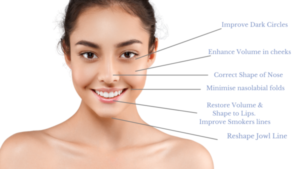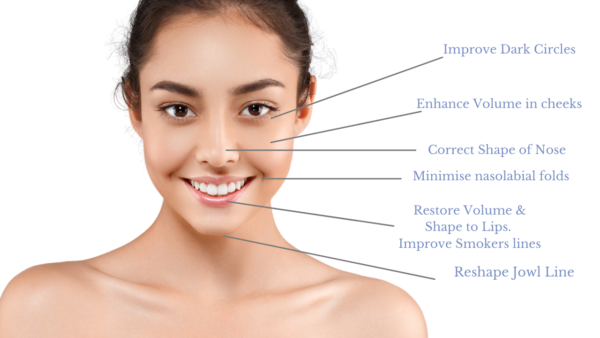Dermal Filler San Diego is an easy way to reduce wrinkles, contour the face, and create volume. They are soft injectable gels made of stabilized hyaluronic acid, which exists naturally in the skin.
Facial fat grafting is a different procedure, where your fat is removed via liposuction and purified before being injected. It is an outpatient procedure.

With dermal filler becoming increasingly popular for cosmetic enhancement, there are many different options available. These injectable treatments can reduce the appearance of fine lines, wrinkles, facial volume loss, and even acne scars. However, the results of the procedure can vary depending on the type of filler used. This is largely due to the different types of dermal filler materials that are currently on the market, including hyaluronic acid (HA), polymethyl methacrylate, calcium hydroxylapatite, and more.
Hyaluronic acid fillers are a common type of dermal filler that is known for its ability to smooth and erase fine lines, wrinkles, and creases. These injectables can also add a slight lift to the face for a more refreshed look. HA fillers are also great for improving undereye bags, sagging eyebrows, and thin lips.
This family of fillers includes Voluma, Juvederm, and Restylane. These products all contain hyaluronic acid, a naturally occurring substance in the body that helps skin cells retain moisture. This allows the skin to stay hydrated and healthy-looking. These products are considered temporary, as the hyaluronic acid will break down and be absorbed by the body over time. This is why it is important to visit your doctor for regular touch-ups.
Another option is a semi-permanent filler, such as . Unlike hyaluronic acid fillers, this product is not a synthetic material, and it actually works to stimulate your own body’s natural collagen production. This results in a gradual improvement over the course of three treatment sessions.
Finally, there are autologous injectables, which use a patient’s own fat to treat their face. In these cases, the doctor will harvest fat cells from the belly, thighs, or buttocks and then process them in order to inject the cells into the face. This can be beneficial for patients who are concerned about allergic reactions to other dermal filler products. These results are also considered semi-permanent, as the fat cells will eventually be reabsorbed into the body over time. This type of dermal filler is a good choice for people who are looking to reduce the signs of aging, rather than treating acne scars or sagging eyebrows.
A medical professional will start by cleansing the area to be treated. Then, depending on the treatment and your needs, they will apply a topical numbing cream, chill the skin with a cold tool or use an anesthetic injection to minimize discomfort (optional with most fillers). Once you are comfortable and ready, your practitioner will inject the dermal filler in the appropriate locations. Each injection should take just a few moments. After the injection, they may massage the area to disperse the filler and ensure that it is even and meets your goals. Depending on your personalized treatment, this part of the procedure can take between 15 minutes and an hour.
The treatment may leave the area slightly red, sore and swollen. This should be resolved in a few days. It is recommended that you avoid makeup for a few hours after the treatment to let the swelling subside. It is also advisable that you stay out of the sun until it has completely healed, and that you follow any advice given to you about preventing further bruising and swelling (e.g. avoiding blood-thinning medications like aspirin, warfarin, dipyridamole, clopidogrel, fish oil supplements, garlic tablets, St John’s wort and ginseng).
If you have chosen to use bovine collagen, your results will appear gradually over the course of a few months. This is because this type of filler works by stimulating your own body’s natural production of collagen. It is recommended that you have regular monthly treatments to achieve the best results.
Some types of dermal fillers contain lidocaine and epinephrine to reduce pain and discomfort during the procedure. These ingredients may also reduce the amount of postinjection bruising. In addition, a small needle size, a slow injection technique, and the use of a filler that is highly viscous and contains micro-spheres may all help to limit postinjection bruising. It is also recommended that you avoid alcohol and coffee before your appointment to further limit bruising. Bruising is a common side effect of most nonsurgical procedures, but it usually fades within a few hours to a couple of days.
The recovery process for a dermal filler procedure is fairly quick and easy. Some redness and sensitivity may occur in the injection area, but this should fade within a day or two. Some bruising may also occur, but this typically resolves in a few days. During this time, it is important to avoid excessive heat inducing activities such as hot showers, saunas, and exercise. This will help to reduce swelling and bruising in the treatment area.
Using a topical ice pack can also be helpful in reducing sensitivity and swelling after the treatment. It is also advised to sleep in the proper sleeping position, avoiding direct pressure on the treatment areas while you sleep. This will help to ensure that the filler settles evenly in the treatment area, resulting in natural-looking results.
Injection into a blood vessel is a rare complication of dermal fillers but when it does occur it can cause serious medical problems including necrosis (death of tissue), impaired blood flow, and vision abnormalities such as blindness or stroke. If a patient experiences any signs of an injection into a blood vessel, such as blanching of the skin, change in vision, or unusual pain during or shortly after the procedure, they should seek immediate medical attention.
Dermal fillers are becoming a popular and effective way to smooth fine lines and wrinkles, enhance facial contours, and add volume to the lips and other areas of the face. However, there are some precautions and guidelines that Greater Houston-area patients should follow for the best possible results and experience with this treatment. This blog will explore essential guidelines for proper aftercare of a dermal filler to maximize the benefits and minimize side effects. Some of these guidelines include avoiding touching or rubbing the treatment area, sleeping in the proper position, and other important tips. We’ll also discuss the importance of a follow-up appointment to monitor the progress and outcomes of your treatment.
Many dermal filler complications are preventable. They often occur due to the use of non-sterile products purchased from a non-clinical source (black market). They can also be caused by injectors who are not trained, use inappropriate injection techniques, or apply too much product to a particular area. Patients can minimize the risk of adverse effects by avoiding blood-thinning medications and supplements, including aspirin, warfarin, dipyridamole, clopidogrel, fish oil, St John’s Wort, garlic tablets and gingko biloba; following aftercare recommendations; and reporting any suspected side effects.
Some types of fillers can cause subclinical granulomatous inflammation, which is expected in some cases but is not desirable. This reaction can result in tissue ischemia, pain, erythema, and sometimes a hard nodule. It usually starts with a single site of inflammation and progresses over time, with periods of crisis and regression. It can be difficult to differentiate from a nodule that was caused by misplacement of the filler.
A small number of complications are acute and require immediate treatment. Vascular occlusion is the most serious of these and must be ruled out in all patients who present with dermal fillers. It can be obfuscated by ecchymoses, thrombosis and decreased capillary refill. Treatment may include a warm compress, massage, application of glyceryl trinitrate paste and injections of hyaluronidase (an enzyme that dissolves hyaluronic acid).
Biofilms are one of the most common causes of delayed-onset complications of filler injections. These include granulomatous inflammation, abscesses, or nodules, which can be extremely difficult to treat. They are most often associated with hyaluronic acid fillers, but can occur with any type of filler. Treatment includes antibiotics such as ciprofoxacin and clarithromycin XL, which must be started before culture results are available.
Nerve injury is a very rare but serious complication of filler injections and can be caused by direct trauma where the nerve is pierced or partially lacerated by the needle, injection into the nerve, compression of the nerve foramina by filler and excessive molding and massage. It can lead to a patch of anesthesia in the zone of innervation, which is typically reversible.
